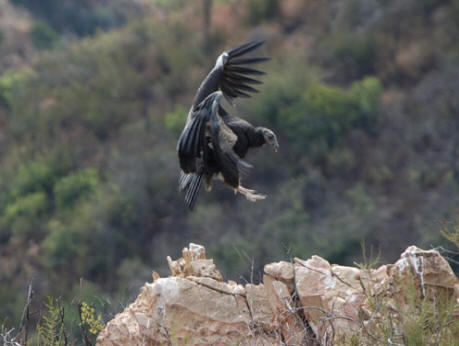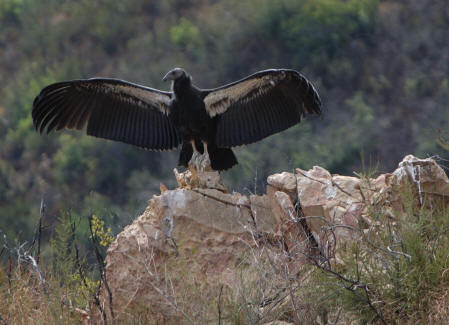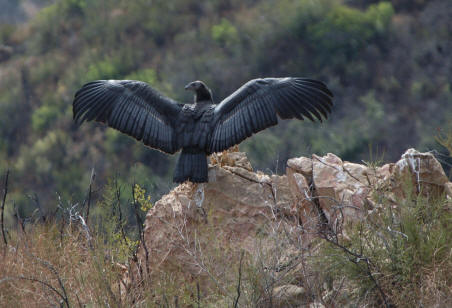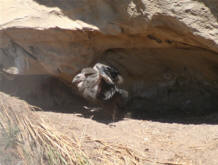|
November 20, 2006
CONDOR CHICK TAKES FLIGHT NEAR
LOS PADRES NATIONAL FOREST
The second California condor chick to fledge in the wild in
California in more than 14 years has left its nest at the Hopper
Mountain National Wildlife Refuge near the Los Padres National
Forest in Ventura County.
The six-month old chick, dubbed "Number 412," left its nest for the
first time October 22, flying approximately 15 feet across a
canyon and landing on a cliff face.

The bird continues to make short flights near the nest site. At least one parent is nearby keeping a
watchful eye on the bird as it explores the surroundings. The
parents will continue to care for the juvenile condor until it's approximately 18 months old.
The chick was hatched May 2 near the refuge, home to
the California Condor Recovery Program. It's the
first chick to fledge in the wild in California since 2004, and
the second since the federally-protected condors were reintroduced
in 1992. This brings the total number of California condor
chicks to fledge in the wild to seven. Five condor chicks have
fledged in Arizona.

"This is a significant event; each time a condor chick fledges
in the wild it brings us that much closer to the goal of the
recovery of this great bird," said Steve Thompson, an official
with the U.S. Fish and Wildlife Service.
The year began with four breeding pairs of
condors. Two nests failed at the egg stage, and the third nest
failed after the chick fell from the nest site. Number 412, the
most recent chick, was born to a new breeding pair of condors
this year, a six-year-old female and a five-year-old male. At
one point, the chick had to be removed from the nest, taken in
for surgery, and returned to the nest the following day.
The largest bird in North America, condors are scavengers that
have soared over mountainous areas of California since
prehistoric times, but their numbers plummeted in the 20th
Century. Condor numbers declined in part due to loss of habitat
and food and from shooting, lead poisoning, oil development,
power line collisions, and toxic substances.

Condors were
listed as an endangered species in 1967, under a law that
pre-dated the existing Endangered Species Act. In 1982, the
condor population reached its lowest level of 22 birds,
prompting biologists to start collecting chicks and eggs for a
captive breeding program. By late 1984, only 15 condors remained
in the wild. After seven condors died in rapid succession, it
was decided to bring the remaining birds in from the wild for
the captive breeding program. In 1992, the Recovery Program
began releasing California condors back into the wild.
 
Photos courtesy U.S. Fish &
Wildlife Service
Mike Wallace, Zoological Society of San Diego
|